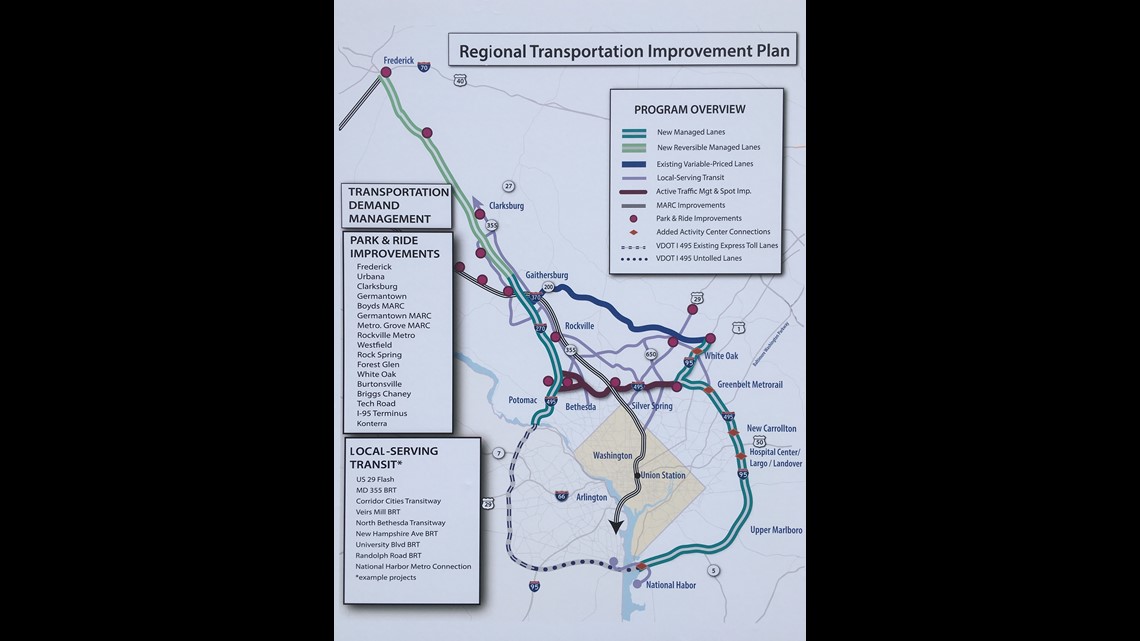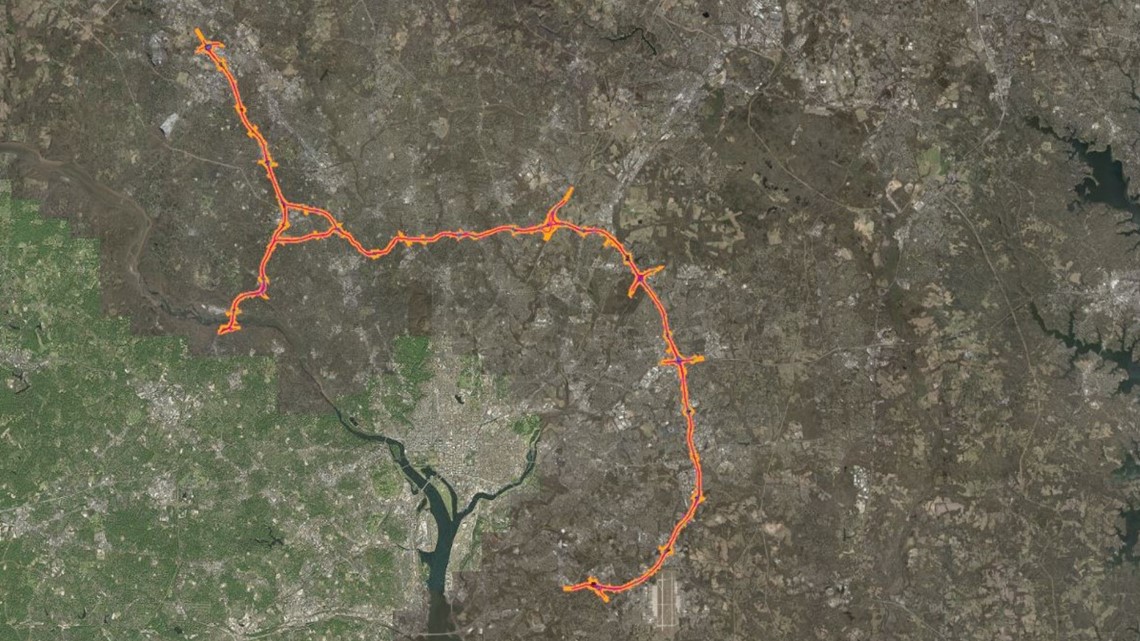SILVER SPRING, Md. — Officials in three Maryland counties, alarmed at Gov. Larry Hogan's plan that would take parks and homes to build toll lanes on the Capital Beltway and Interstate 270, said Monday they have an alternative that makes more sense for congestion, their communities and the environment.
As many as 34 homes and four businesses close to the Beltway may be in the path of the widening, according to the Maryland governor's preliminary plan. None would be destroyed along I-270.
But county officials and other activists also are concerned about the long-term environmental effects of building two toll lanes in each direction and the fact that close to 1,500 properties, including public parks and school playgrounds, could be taken for the project or lose use of backyards during construction.
"We see well-intentioned proposals that are flawed all the time, and it's our job to fix them," said Tom Hucker, the transportation chairman of the Montgomery County Council.
► MAY 26: Could a monorail be the answer for I-270? Developer says yes
► APRIL 14: Dozens to be dislocated in plans to widen Capital Beltway
He and more than a dozen other local officials and Maryland state delegates said Hogan and his staff did not consult people in the path of the project before unveiling the plan that is up for a key vote Wednesday before the Maryland Board of Public Works.
Hucker laid out seven points of a solution to lessen traffic congestion that he said local leaders want:
1. Concentrate first on the corridor from the Potomac River to Frederick, Maryland, including improving the American Legion Memorial Bridge between McLean, Virginia, and Cabin John, Maryland.
2. Make improvements on the Beltway east of I-270 within the current right of way, including use of lane metering and shoulders during rush hours.
3. Use the Intercounty Connector to help drivers get to Virginia more quickly. Maryland 200, which opened in November 2011, is an almost 19-mile toll road now below capacity that connects Laurel and Gaithersburg and goes from I-95 to I-270.
4. Build reversible lanes in Frederick County north of Clarksburg to Frederick, similar to the I-95 reversible toll lanes south of Springfield in Virginia.
5. Dedicate some of the resulting toll revenue to transit.
6. Encourage transit use, carpooling, electric vehicles and telecommuting among other options. Montgomery County developer Robert Eisinger also has proposed a 27-mile monorail from Frederick to the Shady Grove Metro station that he said would fit within the I-270 right of way, an idea that also intrigues the officials gathered Monday for their news conference.
7. Create managed lanes that don't stop at the Maryland-Virginia state line. Those types of lanes, which could include express lanes, bus-only restrictions or high-occupancy vehicle traffic, should continue on the southern part of the Beltway into Virginia and as far north as Amazon's new headquarters in Crystal City, Hucker said.
The governor is proposing to widen almost 40 miles around the Capital Beltway from the American Legion bridge eastward to just west of Branch Avenue. Also in his plan is widening about 30 miles from I-270 at the beltway to I-70 in Frederick.
Hogan envisions his $11 billion plan as a public-private partnership and an extension of the I-495 toll lanes now in operation in Virginia. The Virginia lanes span 14 miles from I-95's Springfield interchange clockwise on the Beltway to a little north of the Dulles Toll Road.


By enlisting a private company, Hogan hopes to shorten the time to completion and shift the construction costs to the winning bidder. The carrot for the winning company: a big portion of toll revenues for the next 50 to 100 years.
► JAN. 30: Maryland says replacing American Legion bridge is first priority
► DEC. 7: TransUrban deal stops Va. from adding lanes to fix I-95 bottleneck
Opponents of the privatized toll road plan are trying to put the brakes on Hogan's proposals before they become an unstoppable juggernaut. Maryland is already committed to spending $90 million on studies.
Texas-based engineering firm Fluor and Australian toll-road operator Transurban built Virginia's additional two lanes in each direction in about seven years from agreement to opening at a cost of $1.9 billion, including $400 million from the state of Virginia. They're collecting all of its toll revenue, at least at first, to recoup the costs of building the express lanes.
The plan does not call for widening in Montgomery County that would result in condemnation of homes and other property.
“Our proposed alternative is more balanced, less disruptive, more protective of the environment, and most important its more effective at relieving congestion than MDOT’s plan,” said Montgomery County Councilmember Tom Hucker who was surrounded by leaders from both counties as well as Silver Spring neighbors concerned that widening will destroy the Indian Spring Terrace Park and adjacent YMCA.
The Maryland Board of Public Works is scheduled to vote Wednesday on Hogan's plan to create a public-private partnership, a vote delayed from May 8. State Treasurer Nancy Kopp, has been skeptical of Hogan's plan, is one of three on the board and was unable to attend the May 8 meeting because she was out of the country.
Kopp serves on the public works board with Hogan and Maryland Comptroller Peter Franchot. In December, she wouldn't vote to approve a $90 million contract to study the design and construction of the project.
► DEC. 7: I-66 Express Lanes improving rush hour commute
► DEC. 4: Commuters complain new I-66 tolls are 'highway robbery'
"If you're willing to spend $11 billion, $13 billion, I don't know what the most recent number is on a public-private partnership, you should be willing to work with the local governments," Montgomery County Executive Marc Elrich said Monday.
Hogan has put forth a plan that he said he'll submit to the 2020 Maryland General Assembly to get the state to zero carbon emissions for electricity generation by 2040. And last month he allowed a bill to become law that mandates half of Maryland's energy to come from renewable sources by 2030.
"The governor has set some very ambitious environmental goals," Elrich said. "You can't do that if you ... focus on cars."
Kai Hagen, a Frederick County Council member who had to travel south on I-270 to get to Monday's news conference at Indian Spring Terrace Park in Silver Spring, also was concerned about the sole focus on cars.
"With all of the solutions that we can come up with, ... we are picking the box that is the single worst solution, including doing nothing, that affects climate change," he said.
A spokesman for Governor Larry Hogan said the governor is ready to hear more from local leaders, but she questioned the timing of the release of the alternative plans unveiled by Montgomery and Prince George's leaders Monday.
“While it is certainly encouraging that local officials have changed course and finally presented their own congestion plan, countless of their constituents continue to sit in soul-crushing traffic," said Sharese Deleaver-Churchill. "Where have these plans been for the past decade? The governor looks forward to hearing more from county councilmembers and legislators this week.”
Linda Dono, WUSA, contributed to this story.



